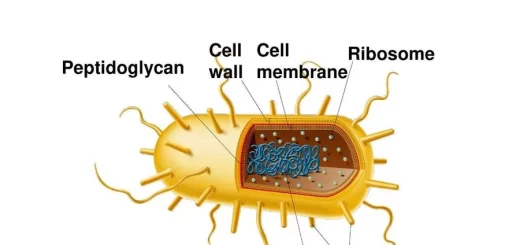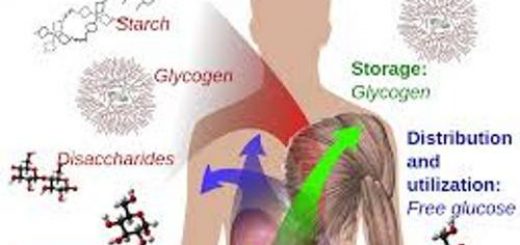Structure of Female genital system and ovum, Oogenesis stages and Menstrual cycle
Female genital system produces ova, It secretes the female sex hormones, It provides a safe place for the completion of the fertilization process of the ovum and for the embryo development till birth, Organs of female genital system lie behind the urinary bladder in the pelvic region, they are firmly connected in this position with elastic ligaments which allow their expansion during pregnancy.
Female genital system
The female genital system of human consists of The two ovaries, The two Fallopian tubes, Uterus & Vagina, As a female approaches maturity (at the age of 12 – 15 years), there are monthly rhythmic changes that take place in the female genital system according to the ovarian, uterine activities and what is correlated with them of fertilization and pregnancy or non-pregnancy and the monthly bleeding menstruation.
At the age of (45 – 50 year), the ovaries become inactive, therefore hormones secretion decreases, the uterine lining shrinks and menstruation stops, This is known as menopause.
The two ovaries
They lie on the two sides of the pelvic cavity, Each ovary is oval in shape and the size of a peeled almond, During childhood, each ovary contains several thousands of ova in various stages of development, After maturity, about 400 of these ova only will mature during the thirty years of active reproductive life (fecundity years).
From each ovary, one mature ovum is discharged alternately with the other ovary each month, Importance of the ovary is the production of ova, The secretion of the maturation hormones for regulating the menstrual cycle and embryo development.
The microscopic structure of the ovary: By studying a transverse section of the ovary, we notice that the ovary consists of a group of cells in different development stages, The ovum is placed inside the Graafian follicle, The Graafian follicle is transformed into the corpus luteum after the releasing of the ovum from it.
The two Fallopian tubes
Each oviduct (Fallopian tube) begins with a funnel-shaped opening that lies just opposite the ovary to ensure the fall of ova in the Fallopian tube, It is provided with finger-like processes to receive the ovum, Each Fallopian tube is lined with cilia to direct the ovum towards the uterus.
Uterus
It is an elastic muscular sac-like organ that presents in the pelvic cavity and provided with a thick strong muscular wall, It is lined with a glandular membrane, It ends with a cervix which opens into the vagina, The embryo is formed inside the uterus for nine months.
Vagina
It is a muscular tube whose length is about 7 cm, It starts from the cervix and ends with the genital opening, It is lined with a glandular membrane that secretes a mucous fluid to moisten the vagina, It has folded to allow its expansion during birth.
Oogenesis stages
The process of oogenesis passes through three important stages which are as follows:
Multiplication stage: This phase occurs during the development of the female embryo, where: Mitotic division takes place to the primary germ cells (2n), This division results in the formation of cells that called oogonia (2n).
Growth stage: This phase occurs during the female embryo development, where: The oogonia (2n) stores an amount of food, increases in size, and transforms into primary oocytes (2n).
Maturation stage: The primary oocytes (2n) divide by first meiotic division, giving: Secondary oocyte (n) & Polar body (n), The secondary oocyte is larger than the polar body, as it contains the stored food.
The secondary oocyte divides by second meiotic division, giving: Ovum (n) & Polar body (n), The second meiotic division occurs once the sperm penetrates the ovum to accomplish the fertilization (it is a delayed or conditioned division).
A second meiosis division may occur to the polar body (n), giving two polar bodies (so that the total polar bodies number is three).
Structure of ovum
The ovum contains a nucleus and cytoplasm, It is enveloped with a thin cellular coat whose cells are held together by the action of hyaluronic acid, Therefore, millions of sperms are required to penetrate the ovum, where the enzymes that are secreted from the acrosome of the sperms (hyaluronidase enzyme) dissolve this coat at the penetration position.
Breeding cycle
The breeding cycle is a certain period in the life of placental mammals, where the ovary becomes regularly active in the adult female, These periods are synchronized with the sexual function of breeding and reproduction.
The period of the breeding cycle differs in the various mammals, where it may be:
- Annually: as in the lions and tigers.
- Two breeding cycles per year (Semi-annually): as in the cats and dogs.
- Monthly: as in the rabbits and rats.
- Every 28 days: as in female human which is known as the menstrual cycle, where the two ovaries alternate with each other in the production of the mature ova.
Menstrual cycle
This cycle is divided into three stages, as follows:
Stage of proliferation
The anterior lobe of the pituitary gland secretes the follicle-stimulating hormone (FSH) that stimulates the ovary to form the mature Graafian follicle which contains the ovum.
The growth of the Graafian follicle takes about 10 days, The Graafian follicle secretes during its growth the oestrogen hormone which stimulates the growth of the endometrium.
Stage of ovulation
This stage starts when the anterior lobe of the pituitary gland secretes the luteinizing hormone (LH) on the 14th day which stimulates the rupture of the Graafian follicle, the release of the ovum and the formation of corpus luteum from the Graafian follicle remains.
The corpus luteum secretes the progesterone hormone which increases the thickness of the endometrium and its blood supply (preparing the uterus to receive the embryo), This stage lasts about 14 days.
Stage of menstruation
This phase occurs, if the ovum is not fertilized, where: The corpus luteum degenerates gradually, then the secretion of progesterone hormone decreases that leads to the:
- Degeneration of the endometrium and the tear of blood vessels, due to the successive contraction of the uterus.
- Occurrence of the menstrual bleeding which lasts about 3-5 days, then a new cycle of the other ovary begins.
In case of the ovum fertilization:
- The corpus luteum remains to secrete the progesterone hormone which inhibits ovulation, therefore the menstrual cycle stops till after birth.
- The corpus luteum reaches its maximum growth at the end of the third month of pregnancy.
- The corpus luteum starts to degenerate in the fourth month of pregnancy, and this is when the placenta growth in the uterus develops and becomes ready to replace the corpus luteum in secreting the progesterone hormone which stimulates the mammary glands to develop gradually and to preserve the endometrium.
The placenta replaces the corpus luteum in the fourth month of pregnancy and secretes the progesterone hormone so that if the corpus luteum is removed or degenerated before the fourth month of pregnancy (before the placental growth is completed), the abortion occurs.
Organs of male genital system, Structure of the testis, Functions of Sertoli cells & Leydig cells
Productive organs, Germ cells, Fertilization, Stages of cleavage, Implantation & Decidua
Reproduction in Human being, Structure of Male genital system & sperm
Fertilization process, Pregnancy and the stages of embryonic development
Childbirth, lactation, types of twins, problems related to childbearing & gametes banks
Placenta types, structure, function, development & abnormalities



